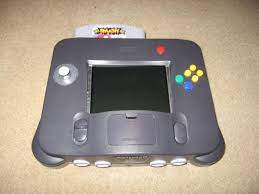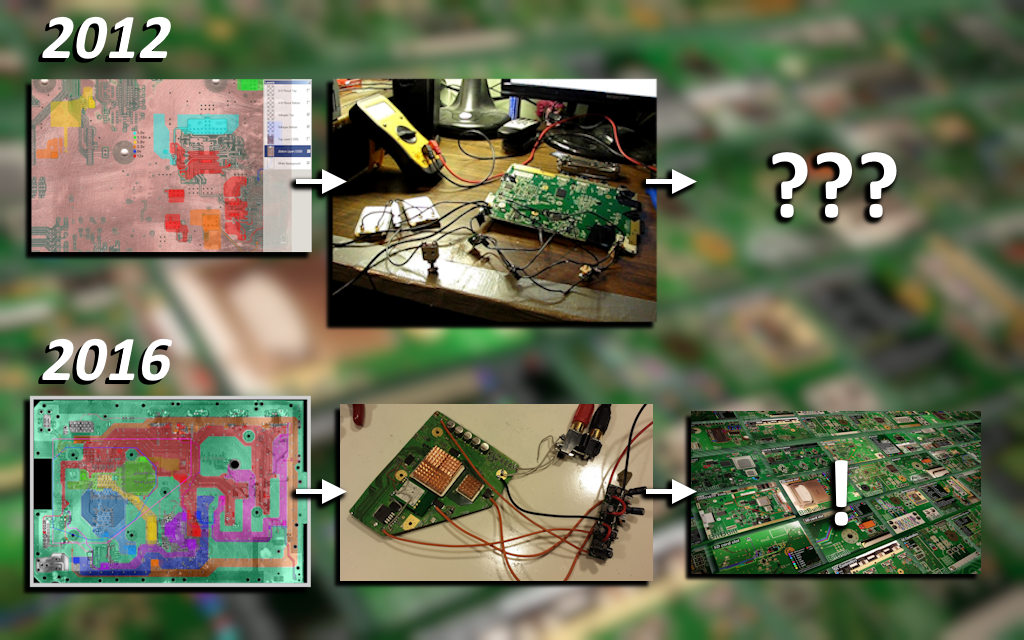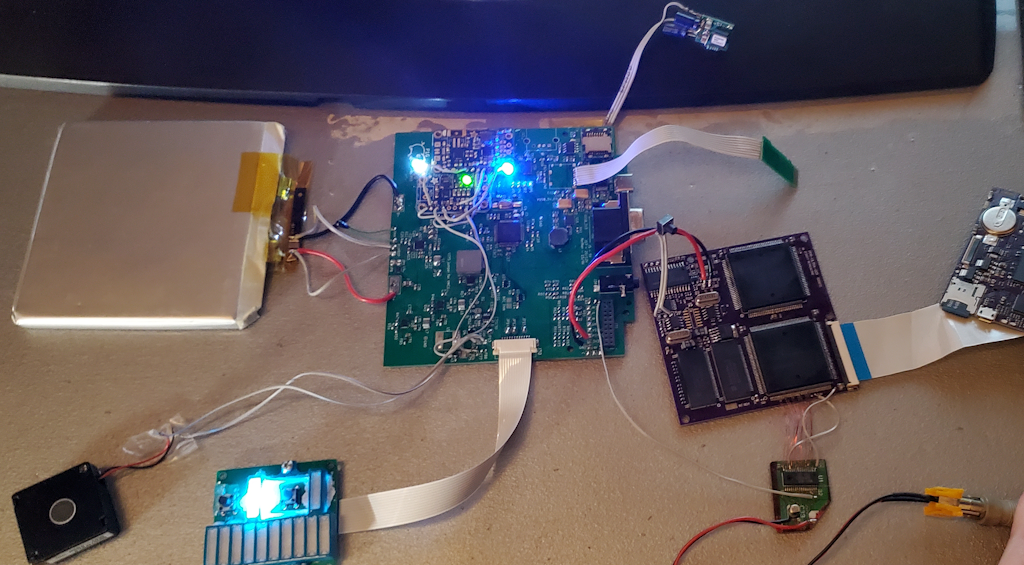
I’m beginning to notice some improvement.
Portablizing is the act of taking what would be considered a stationary home console, and adding a screen, batteries, and often a built-in controller in order to make said console into a portable one. The image above demonstrates two things, I think. The first is that this practice has been around for some time, possibly even predating the the early 2000’s. The second is that often times this is more of an art than a science.
I first discovered portablizing back in 2006, after searching the internet for something along the lines of “cool stuff to do with an N64,” since I had recently completed a childhood goal of actually owning one. I stumbled upon the following picture which changed my life forever:

The Legend who made this also made the UltraHDMI and 64Drive! A true master of his craft.
Seeing that blew me away. And honestly, I think it still holds up today. But in that moment my mind immediately began to race with how insane it would be to have something like that. Shortly after, I found even more pictures and information; I remember finding a huge N64p in a some kind of giant purple plastic case and figured – “Yeah, maybe I could make something like that?” So I joined the community of the time and immediately began making a fool of myself online, which I think is still a right of passage of being a teenager online.
So, as an overly excited teenager with nearly no practical skills and access to dangerous tools, I did the only logical thing and began my attempts to replicate what I had seen on the internet. With relatively sparse documentation and my still-developing critical thinking skills, it took me nearly a full year of failure before I finally had something that technically met the criteria of being a portable, which is what’s pictured in that first god-awful image. However, it obviously wasn’t as good as the other portables I had seen, and I was already trying to figure out a v2 in my brain before I had even completed it.
This particular feedback loop would continue for some time, and in those first few years I went through lots of expensive hardware just to practice my “craft.” Eventually I progressed to the point where I was able to briefly claim the record of “World’s Smallest N64p” in 2010 – since that was one of the metrics of what made a portable good back in the day. (You can see it in the current record holder Gman’s video here!)
During these times, I was able to figure out a few nifty tricks here and there, and posted about them on whatever forum we were all huddling around at the time. I made lots of little guides and images to try to help people like myself, since I remembered how hard it was for me to figure things out when I first started. I’m told that occasionally these were helpful. However, it would still be several years until I would complete my true magnum opus of portablizing.

If at first you don’t succeed, wait four years I guess?
Y’see, sometimes you can be on the right track, but still gain no traction. The image above shows the research that was actually taking place right here on ShockSlayer.com back in 2012! In my travels I had picked up this “compendium” technique from one of the friends I had visited, and was applying it to great effect with the Wii, a full four years before it would be fully realized as part of the big portablizing revival in 2016. But alas, a variety of factors halted my attempts and I moved on to other projects instead.
During this time, there was a veritable thunderstorm of factors leading into the creation of BitBuilt, and I’ve largely boiled down my own motivations to two things. The first was after 10 years, although my flame for portablizing had largely died out, in the back of my mind there was still tons of untapped potential with the Wii; and it’s hard for me to shake that kind of thing. The second was that new life had sprung from the ashes of a once-great scene: a group of individuals who would become the first of a new generation of portablizers sought me out for help in their own endeavors, and this was something I could not ignore. The storm had arrived, and the job of any good ShockSlayer is to be the lightning rod that your community needs; to collect and focus the energy, while protecting the electronics within by sticking a big metal shaft onto your house.
Within a year, we had launched BitBuilt, having formed a collective effort – iterating over the compendium, organizing and identifying as much information as we could, which finally all culminated into the first major Wii trim, dubbed the “OMGWTF Trim” (a community in-joke from the GameCube trimming guides of old.) This directly lead into the creation of the Definitive Wii Trimming Guide, which I consider my own hallmark achievement in portablizing. The methods outlined within are still the standard today, with the successive iterations of the “LMAO trim” and “OMEGA trim” reserved for the more adventurous portablizers out there. (You can see the OMEGA trim in action here, in Shank’s KillMii.)
Being largely driven only by the desire to produce resources for the community, it would be a full two years before I would actually attempt to complete my own Wii portable using all this modern technology. The WaveRider was an ambitious design that would attempt to use the OMEGA Trim to its fullest, and upon its completion in 2018, for a brief period of time, it was the most powerful Wii portable on Earth. The WaveRider was meant to serve as the ultimate showcase of what was to come down the pipeline next. Unfortunately, the waves it rode upon were too close to the sun, and the unit did not survive the trip back from Midwest Gaming Classic, a strange little convention forever tied to portablizing by the guards even older than I. This was, of course, extremely disheartening, and like any good blaze of glory, I went with it.
Or perhaps, I would have, had a strange little green pig not pulled me out of the way at the last second. You see, communities are an interesting thing. As you unite for a common goal, you also get to know your fellow compatriots on a more personal level, and sometimes this can lead to the beginning of wholly different adventures entirely. Before this cataclysmic event, two things had already happened. The first was that The Legend who made the portable that started me on this wild adventure was also still around after all this time, and during “the BitBuilt adventure” he was kind enough to hook me up with some extremely spicy N64 hardware. After putting it together I immediately proceeded to do absolutely nothing with it, because you always save the best for last. The second was the other co-founder of BitBuilt had always been interested in making a fan game, something I largely had no interest in, until he showed me what was possible. This then stoked my interest, and it was a whole thing, y’know? But that project had just been completed a few months prior, and the stage had been set for what was likely the last portable I’ll ever produce.

The longer you look, the worse it gets!
This final unit came in response to a need, not a desire – for there is an intrinsic link between this particular fan game and the N64, a link which I have strived to maintain since the beginning. And for the longest time, this spicy hardware was the only method I had to perform any tests to ensure the link remained constant. The problem was its current form was a series of flex cables and wires – not exactly the kind of thing that’s going to last a long time being shuffled around. Each time I would take it out, I was consumed by an overwhelming cosmic fear that I was moments away from ruining this set of one-of-a-kind hardware – one of my most prized possessions. And in time, this built up to an all-encompassing realization.
I wasn’t finished yet. And portablizing wasn’t finished with me. It’s never finished with me.
So, with it now being 2021, I set off on one last mission, and I used the modern techniques – custom PCBs, 3D printing, and lots of help from one of my totes besties from back in the day. At last, I was able to complete this final portable. It was designed with the sole purpose of being stable enough for sustained testing, with some extra spice on the side to complement the hardware within. And, it accomplished that mission; which is all you can hope for in the end.
While this last unit may not be the end of my involvement with portablizing, I’m confident that the story I’ve been a part of until now is at least resting on a satisfying conclusion. The same kind of community that gave me all that I am still thrives today, and is built on relatively solid foundations that I’m proud to have helped lay down. There are good people there, helping young minds learn to make more of themselves and the world that they’re in, in a unique and interesting way, just like I once did. I’m glad that I was able to be a part of it, and was able to tie up all of my own personal loose ends before making an exit. I may have made more than a few mistakes along the way, but I think everything worked out for the best.
For now, I’m content to sit on the sidelines, but who knows what the future holds. The call may come again. The urge may resurface. And if that happens, I feel pretty confident that I’ll stand up once again.